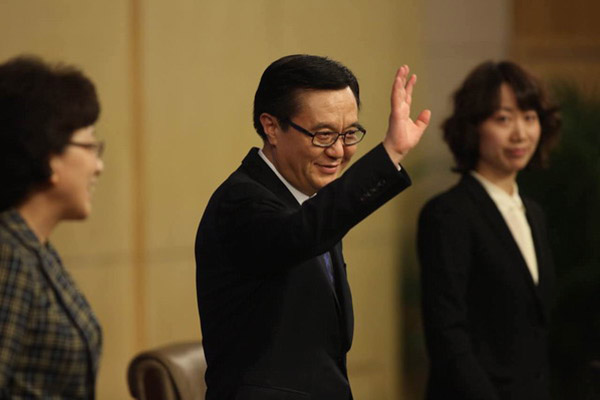
China’s Minister of Commerce Gao Hucheng takes questions from journalists at a news conference during the ongoing two sessions in Beijing, on March 7, 2015.[Photo by Wang Jing/chinadaily.com.cn]
More than 100 million Chinese took foreign trips in 2014 and their overseas consumption surpassed 1 trillion yuan ($159.62 billion), said Gao Hucheng, Minister of Commerce, at a news conference on March 7.
The main reason for the boom in overseas consumption is the price difference between the domestic and international markets, according to the minister of commerce.
The difference was primarily caused by high taxes and fees, especially the consumption tax on certain products, high cost of domestic circulation and price strategies of foreign brands, Gao added.
Other highlights at the news conference.

China’s Minister of Commerce Gao Hucheng (center) takes questions from journalists at a news conference during the ongoing two sessions in Beijing, on March 7, 2015.[Photo by Wang Jing/chinadaily.com.cn]
Export growth will turn positive in March
China’s export and import will end contraction and usher in a positive growth in March.
The foreign trade in February, based on the analysis of leading indicators, will remain a negative growth, but the decline rate will narrow significantly, said Gao.
Trade in January fell by more than 10 percent, with export sliding by 3.2 percent and imports plunging 19.7 percent, according to data from General Administration of Customs.
The country plans to set this year’s target for foreign trade growth to 6 percent from 7.5 percent, announced Premier Li Keqiang in the draft work report.
“Provided a fairly same environment with no significant changes compared to last year, international demand will remain a moderate growth, and we are confident to achieve the target,” said Gao.
Apart from non-comparable factors, China’s foreign trades grew 6.1 percent in 2014, with export up 8.7 percent, said Gao, adding that the sharp price decline in import commodity was the main reason why last year’s target was missed.
Gao said the export growth in 2014 was satisfactory, given the base of years of 9 percent growth from 2008.
“A fundamental estimate is that until now, we can’t see any sign of a quick rebound to the price of resources, energy and bulk farm products,” said Gao.

China’s Minister of Commerce Gao Hucheng (center) waves to journalists at a news conference during the ongoing two sessions in Beijing, March 7, 2015.[Photo by Wang Jing/chinadaily.com.cn]
China has confidence, ability to sign FTAs with the world
China’s free trade agreement (FTA) talks with Australia indicates that China has the confidence and ability to develop the talks with countries and regions around the world, said Gao Hucheng, Minister of Commerce, on March 7 at a news conference.
Australia is an important trading partner of China, and the country’s market access rules, investment and trading codes, the related standards and all the management systems are almost the same as the developed countries in the west.
China has until now signed FTAs with 20 countries and regions around the world, covering nearly 30 percent of the country’s foreign trade.
Based on the newly initiated China-ROK FTA, China will accelerate the FTA talks between China, Japan and the Republic of Korea (ROK).
Gao said the upgraded talks on China-ASEAN FTA will be the most important one in 2015.
Background information: China targets 6 percent rise of foreign trade
China sets a target to increase imports and exports by around 6 percent, said the Government Work Report delivered by Premier Li Keqiang
The government will transform and upgrade China’s foreign trade, improve the mechanism for sharing the cost of export tax rebates between the central and local government, with the central government paying all the year’s increase over last year for the benefit of local governments and exporting enterprises, the report said.
The report said that the government will implement policies and measures to enable China’s foreign trade to develop new competitive edges, and will take a more active, more effective approach to making use of foreign capital.
The focus will be on making the service and manufacturing sectors even more open by halving the number of industries in which foreign investment is restricted, the report said.
China will speed up the implementation of the “go global” strategy and encourage Chinese companies to participate in overseas infrastructure development projects and engage in cooperation with their foreign counterparts in building up production capacity.
According to the report, China will work to increase the international market share of Chinese railway, electric power, communications, engineering machinery, automobile, aircraft, electronics, and other equipment, and encourage the metallurgical, building materials and other industries to invest overseas.
China will work with the relevant countries to develop the Silk Road Economic Belt and the 21st Century Maritime Silk Road and will promote multilateral, bilateral, and regional opening up and cooperation.
This year, the central government will increase its budgetary investment to 477.6 billion yuan, according to the report.
